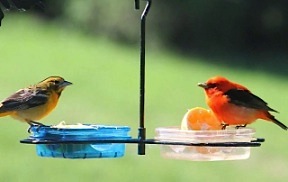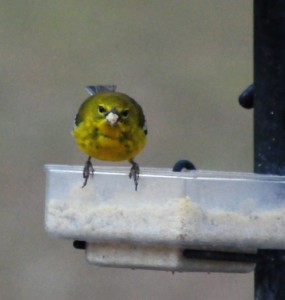- Bird Feeders, Fruit Bird Feeder, Fruit, Jelly & Mealworm Feeders, Live Meal Worms, Mealworm Feeder, Uncategorized
live worms escaping your mealworm feeder?
A customer’s question grabbed our attention: “How do you keep the worms inside the mealworm feeder?”
Tooth, texture… that’s what it’s all about here. If the surface of the feeder is not smooth as glass, the wiggly, crawly delights get hold and simply crawl right out! Now this is a huge advantage to ground feeding birds like robins – ours actually sit and wait below the mealworm feeder. But for bluebirds, chickadees, nuthatches, warblers, swallows and titmice, they have to swoop down to catch their worms if they’ve all crawled out.
So what’s the point of using a hanging dish feeder if worms end up on the ground? Not much! If you’re feeding live worms, it’s best to use a feeder that has absolutely no texture on the inside surface. Worms will stay put longer, and while juveniles are learning to use feeders, this is helpful.
An open dish type feeder will also accommodate a good variety of other treats to entice wild birds. Oranges used in this double-dish model have orioles flocking and teaching babies where the good stuff is! Suet chunks and peanuts are also good options for winter feeding.
Smooth, plexi-glass meal worm feeders like this are available in staked, hanging and even pole-mounted options. They’re durable for year-round use and dishwasher safe. Birds can perch anywhere on the dish – making it easier to land and feed. The vertical hangers are long enough to use with a weather guard, or even a baffle should squirrels be a problem around your place.
If you’re on the squeamish side and can’t bear the thought of live worms, birds will also go for dried worms. In fact they pack more protein per serving! Consider a dish style mealworm feeder this season… they work great for more than just worms!
-
Master of Mimicry~A Cool Video from The Cornell Lab
An extremely cool video from The Cornell Lab of Ornithology, one special catbird in California (which is rare in itself) puts on an extreme show. Known as a master of mimicry, over twenty calls are recorded, side by side with the originator…. even a frog!
Pretty common in our parts during summer months, we had several resident catbirds hanging around the yard this season. Digging into suet and a jelly feeder–until the yellow jackets showed up, they then opted for worms meant for bluebirds! Crafty & smart, they’d wait and watch until the open dish melworm feeder came alive once again.
Actually it became obnoxious, as the worms were for the baby bluebirds! But there were breeding pairs nearby and catbird fledges were soon at the feeder too. It sure was a busy season, likely because of diminished food sources and the horrid drought. Two leaf misters ran daily, and nine birdbaths were maintained! It was great having catbirds around, but good to see them move on as well.
Check out the short video below for some excellent catbird knowledge!
- Bird Accessories, Bird Feeders, Birding Accessories, Bluebird Feeders, Fruit, Jelly & Mealworm Feeders, Mealworm Feeder, Uncategorized, Wild Bird Feeders
The dish style mealworm feeder offers various feed options
Hey lady! What’s up with the Mealworm Feeder?
This little plexiglass dish get big traffic in our yard! When live mealworms are placed in it (most times twice a day) all bets are off. The bird traffic is fast and furious, first come, first served!
Originally meant for our Bluebirds – the Chickadees and Titmice quickly learned of the treasure. So, the Bluebirds soon received their own enclosed mealworm feeder, although Carolina Wrens have since figured that out as well!
Feeding live worms can get expensive when everybody’s in on the coveted treat, and I mean everybody! Even the Robins get a few worms in a glass dish that’s left on the ground. And I can’t stand when the crows get to them first!
Unless you have the time and patience to cultivate your own worms, ordering in bulk quantities is easier on the wallet. The worms really aren’t that expensive… it’s the shipping that gets ya! Since they’re live, overnight delivery is required for warmer temperatures. For a few months out of the year (depending on your location) a second-day delivery works fine.
Gradually decreasing the amount of worms, and adding a home-made suet mixture in this meal worm feeder landed a “so-so” reaction from most of our beaked buddies. This Pine Warbler has a mouthful of the stuff, (which is why his beak looks fat & white) but just look at that expression! It’s like “excuse me, where are my worms?”
This mealworm dish actually has drainage, but many similar styles do not, making them perfect for offering water too. In summer, fresh fruit is a great choice for migratory birds, while suet mixtures & crumbles, and shelled peanuts are good options for cold weather feeding.
Offering live worms has created a whole new dimension to our backyard birding experiences. Definitely worth giving it a try if you’ve never fed them before, especially if bluebirds are in the area. And Robins adore them too! But if you don’t want the birds eating you out of house and home… a more traditional, or enclosed mealworm feeder may be your better choice.



